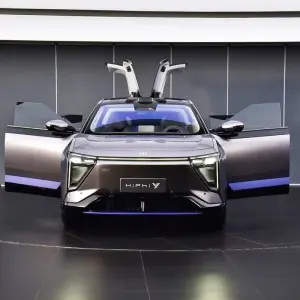New energy vehicles refer to the use of unconventional vehicle fuels as power sources (or the use of conventional vehicle fuels and new vehicle power devices), integrating advanced technologies in vehicle power control and driving, forming advanced technical principles and features Cars with new technologies and new structures.
New energy vehicles include four major types of hybrid electric vehicles (HEV), pure electric vehicles (BEV, including solar vehicles), fuel cell electric vehicles (FCEV), and other new energy (such as supercapacitors, flywheels and other high-efficiency energy storage devices) vehicles wait. Unconventional vehicle fuels refer to fuels other than gasoline and diesel.
The following are detailed categories:
1. Pure electric vehicles Pure electric vehicles (Blade Electric Vehicles, BEV) are vehicles that use a single battery as the energy storage power source. It uses the battery as the energy storage power source, provides electric energy to the motor through the battery, and drives the motor to run. Push the car forward.
2. Hybrid Electric Vehicle A hybrid electric vehicle (HEV) refers to a vehicle whose drive system is composed of two or more single drive systems that can operate simultaneously. The driving power of the vehicle is determined by a single drive system based on the actual vehicle driving state. Available individually or with multiple drive systems. Hybrid vehicles come in many forms due to differences in components, arrangements, and control strategies.
3. Fuel Cell Electric Vehicle Fuel Cell Electric Vehicle (FCEV) uses hydrogen and oxygen in the air under the action of a catalyst. A vehicle driven by electrical energy generated by electrochemical reactions in a fuel cell as the main power source.
Fuel cell electric vehicles are essentially a type of pure electric vehicle. The main difference lies in the working principle of the power battery. Generally speaking, fuel cells convert chemical energy into electrical energy through electrochemical reactions. The reducing agent required for the electrochemical reaction generally uses hydrogen, and the oxidant uses oxygen. Therefore, most of the earliest fuel cell electric vehicles developed directly use hydrogen fuel. Hydrogen storage can take the form of liquefied hydrogen, compressed hydrogen or metal hydride hydrogen storage.
4. Hydrogen engine cars Hydrogen engine cars are cars that use hydrogen engines as their power source. The fuel used by general engines is diesel or gasoline, and the fuel used by hydrogen engines is gaseous hydrogen. Hydrogen engine vehicles are a truly zero-emission vehicle that emits pure water, which has the advantages of no pollution, zero emissions, and abundant reserves.
5. Other new energy vehicles Other new energy vehicles include vehicles using high-efficiency energy storage devices such as supercapacitors and flywheels. Currently in my country, new energy vehicles mainly refer to pure electric vehicles, extended-range electric vehicles, plug-in hybrid vehicles and fuel cell electric vehicles. Conventional hybrid vehicles are classified as energy-saving vehicles.
Simply distinguish the cars with green license plates we see on the street as new energy vehicles.
Post time: Jan-10-2024




